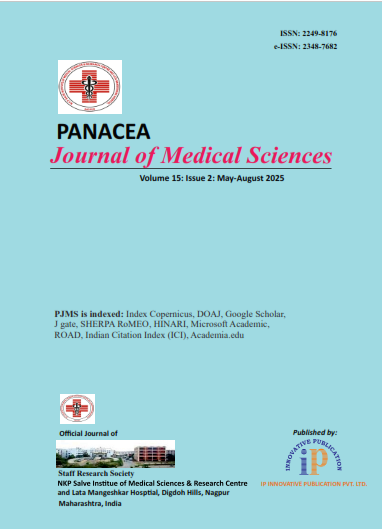Panacea Journal of Medical Sciences
Panacea Journal of Medical Sciences (PJMS) open access, peer-reviewed triannually journal publishing since 2011 and is published under auspices of the “NKP Salve Institute of Medical Sciences and Research Centre”. With the aim of faster and better dissemination of knowledge, we will be publishing the article ‘Ahead of Print’ immediately on acceptance. In addition, the journal would allow free access (Open Access) to its contents, which is likely to attract more readers and citations to articles published in PJMS.Manuscripts must be prepared in accordance with “Uniform requiremen...

The role of diffusion tensor imaging in the early detection and prognosis of cervical spondylotic myelopathy
Page: 351-358
Background: Cervical spondylotic myelopathy (CSM) is a spinal disorder stemming from cervical spine degeneration, elevating the potential for spinal cord damage. Diffusion tensor imaging (DTI) represents an advanced MRI technique utilized to detect subtle alterations in the spinal cord induced by CSM. This paper aims to examine the function and prognostic significance of DTI in the early identification of CSM.
Aims and Objectives: The principal goals and objectives of this research are outlined as follows: 1. The significance of diffusion tensor imaging in assessing initial changes in the spinal cord that T2A-MRI fails to reveal; 2. A comparison of DTI (diffusion tensor imaging) metrics (FA and ADC) with clinical symptoms (mNURICK s and mJOA scores); 3. The forecasting ability of DTI regarding postoperative outcomes in degenerative cervical spondylosis.
Materials and Methods: In our investigation, we scrutinized 30 hospitalized individuals at our university-associated healthcare facility, who exhibited mild myelopathic symptoms but showed no T2-weighted MRI indicators. They were diagnosed with degenerative compressive cervical myelopathy based on DTI imaging. Patients were slated for surgical procedures via either an anterior or posterior method, with or without the incorporation of fusion or fixation apparatus. Each patient underwent DTI imaging both prior to and following the surgery. The post-operative DTI assessment analyzed fractional anisotropy (FA) and apparent diffusion coefficient (ADC). The modified Japanese Orthopaedic Association (mJOA) evaluation was administered before and after the surgery. A regression formula was developed.
Results: Our analysis revealed that the FA value at the compression stage is considerably reduced compared to the non-compression stage (p=0.005), while the ADC value at the compression stage is elevated relative to the non-compression stage (p<0.001). This validates the actual level of compression observed. Following the DTI analysis, the assessment of compression degree showed remarkably enhanced results (FA value increased p < 0.001, ADC value decreased p < 0.001). Additionally, the postoperative enhancements in FA and ADC values exhibited a significant correlation with the improved mJOA scores. Nevertheless, the predictive strength for the FA value stands at 71.8%, while that for the ADC value is 45.5%. The anticipated improvement in the postoperative score surpasses the actual score; however, the statistical relevance of this observation could not be confirmed due to the limited number of subjects.
Conclusion: DTI has demonstrated its efficacy as a remarkable instrument for the timely identification of CSM and the forecasting of outcomes and potential complications in individuals affected by CSM.
Article Metrics
- Visibility 15 Views
- Downloads 5 Views
- DOI 10.18231/pjms.v.15.i.2.351-358
-
CrossMark
- Citation
- Received Date August 22, 2024
- Accepted Date January 26, 2025
- Publication Date August 19, 2025